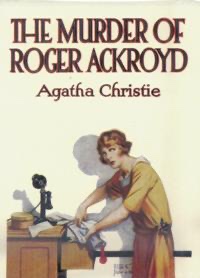
Sanja565658 / CC BY-SA (https://creativecommons.org/licenses/by-sa/3.0).
Over forty years ago, I became a vegetarian. I was a philosophy graduate student at Temple University in Philadelphia, Pennsylvania. Not, in all of the time since, did I become familiar with the term “vegetable marrow.” Recently, however, I encountered it while reading a mystery story by the English writer, Agatha Christie, The Murder of Roger Ackroyd. The book was published in 1926 and is the third of Christie’s Hercule Poirot novels.

Vegetable marrow, according to Funk & Wagnalls Standard Dictionary of the English Language, 1962, is “1. A plant of the gourd family (Cucurbita pepo), having a tender, edible fruit. 2. The fruit, esteemed as a vegetable, also called marrow squash.” According to the definition in Merriam-Webster’s Collegiate Dictionary, Eleventh Edition, the term is chiefly British, which may account for my not being familiar with it. I asked my wife if she had ever heard of it. She had. She first ran across it in the delightful story “Paddington Turns Detective,” in the collection of stories by British author Michael Bond, More About Paddington. In the story, Mr. Brown’s prize “marrow” has disappeared, and Paddington decides to investigate the matter.
A few years ago, I bought a fascinating book, The Novel Cure: From Abandonment to Zestlessness: 751 Books to Cure What Ails You, by Ella Berthoud and Susan Elderkin. The book is, as noted on the flyleaf, “an apothecary of literary solutions.” Its goal is “the prescribing of fiction for life’s ailments,” an exercise in bibliotherapy. The ailments are listed alphabetically. Recently, I decided to look up the flu. The entry opens:
Something that no medical doctor or scientific researcher has yet studied, or even noticed, is the following strange coincidence: the moment a flu patient begins to read an Agatha Christie novel marks the commencement of their recovery. Our favorite is The Murder of Roger Ackroyd, the Poirot mystery that confirmed Christie’s genius as a writer of detective fiction.
Berthoud and Elderkin, The Novel Cure, page 155.
The authors go on to say, “our innate curiosity to find out whodunnit is stronger than the urge to wallow in our fluey misery.” At this point, there is an interesting footnote, one with which my wife heartily agrees. “Unless you have the much more serious strain known as man flu, in which case it’s the other way around. See: Man flu.” Humph! By the way, the couple’s prescription for man flu is the much more weighty Les Misérables by Victor Hugo. Not feeling entirely up to Hugo at the moment, I decided to go with Christie, and I’m happy I did.
In addition to trying to solve the mystery, of course, just to read Christie’s writing is a pleasure. Especially enjoyable is her humor. Here is the scene where James Sheppard – a doctor and the novel’s narrator – first meets Hercule Poirot. It was this scene that sent me to the dictionary to find out the meaning of “vegetable marrow.”
I am rather fond of gardening. I was busily exterminating dandelion roots when a shout of warning sounded from close by, and a heavy body whizzed by my ears and fell at my feet with a repellent squelch. It was a vegetable marrow!
I looked up angrily. Over the wall, to my left, there appeared a face. An egg-shaped head, partially covered with suspiciously black hair, two immense moustaches, and a pair of watchful eyes. It was our mysterious neighbour, Mr Porrott.
He broke at once into fluent apologies.
“I demand of you a thousand pardons, monsieur. I am without defence. For some months now I cultivate the marrows. This morning suddenly I enrage myself with these marrows. I send them to promenade themselves—alas! not only mentally but physically. I seize the biggest. I hurl him over the wall. Monsieur, I am ashamed. I prostrate myself.”
Before such profuse apologies, my anger was forced to melt. After all, the wretched vegetable hadn’t hit me. But I sincerely hoped that throwing large vegetables over walls was not our new friend’s hobby. Such a habit could hardly endear him to us as a neighbour.
The strange little man seemed to read my thoughts.
“Ah! no,” he exclaimed. “Do not disquiet yourself. It is not with me a habit.”
Christie, Agatha. The Murder of Roger Ackroyd (Poirot) (Hercule Poirot Series) (pp. 16-17). HarperCollins Publishers. Kindle Edition.
When reading this, how is it possible to keep in mind any “fluey misery?” For me, at least, it’s not possible. All my thanks to Agatha Christie and my two excellent pharmacists, Ella Berthoud and Susan Elderkin.
I hope this post finds you in good health!
All the best,
Gershon
Another bit of civilization. Thank you so much!
You have reminded me of a charming movie, The Englishman Who Went Up a Hill and Came Down a Mountain. At the beginning, an unseen commentator explains that Wales has relatively few surnames: Jones, Davis, and not many others. Locals therefore differentiate among people with identical surnames. The film then displays still photos of Jones-the-Butcher, Jones-the-End-of-the-World (conspiracy theorist), and Jones-the-Prize-Cabbage…”a name which suits his personality”.
Best wishes at this time. We survived Pharaoh.
LikeLiked by 1 person
I haven’t read Agatha Christie for years. Maybe I should return to her. Marrows are courgettes (zuchini) that are allowed to grow very large. I don’t know at what exact size a courgette becomes a marrow. If you have a marrow, it’s nice to cut it, remove the seeds and stuff the space with (traditionally) minced beef or with vegetables and bake it.
Juliet
http://craftygreenpoet.blogspot.com
LikeLiked by 1 person